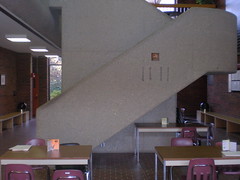Tuesday, September 25, 2007
Chapter 8: Podcasting and Screencasting
With the marketing of the ipod, it is amazing how it has all taken off. If you go into any electronics section of a store, you will see ipod inspired everything. Even items not even associated with ipods are named i-something. Podcasting reminds me of q-tips, it could be called audiocasting just like q-tips are cotton swabs, but the brand name stuck. Like RSS feeds, it seems like podcasting is becoming more popular everyday. The main idea I can see that holds educational value with podcasting is the fact that classes can be recorded and the podcast can be posted online for students that would like to hear the lecture again or if the student missed, they could listen to it. Screencasting is a new idea to me, in which audio can be added to computer video. This could be used for some good things as well as with podcasting.
Tuesday, September 11, 2007
Digital Articles: Reaction
Synching up with the iKid and Adopt and Adapt are two articles that deal with using technology in the classroom. Essentially the idea is that technology is here and nothing can be done about it. The students that we will teach in school have grown up with technology and it is like they are hardwired differently than previous generations. There are people who want to stick to the old ways of teaching, but they have failed; using technology in new ways in schools has had some success. They are interesting articles to read. There are even people in the education field that have varying feelings on how technology should be used, whether it is having a totally wired (or wireless) classroom with no books to having just one computer and going from there. Maybe more technology is not the answer, but it appears to help students become more interested in school, and thats something to take note of.
Reading Response: Chapter 4
Where would the world be without Wikipedia? Chapter 4 is all about the use of wikis in the classroom. Personally, I like the idea of using wikis in the classroom. For example, have the students work on a project, say on George Washington, and they could continue adding information or editing the page. In essence, the students could use the wiki to work on a group essay if you will. Wikipedia is a great tool to help students with research, as long as they use it as a springboard to other things.
Tuesday, September 4, 2007
Parallelogram
This is an example of a parallelogram in the real world. Now, go out into the real world and find 10 examples of geometric shapes in real life. Then, post them to your Flickr account and use the 'Add Note" feature to tell us what the shape is. If you click on the picture of the parallelogram, it will take you to my Flickr account with several other examples of real-life geometric shapes.
Reading Response : Chapters 3, 5, 7
A discussion in chapter 3 is about using weblogs and how to go about this. The tip is to start small and model for the students how to use them. Once the students grasp the concept and are able to use them for items like retrieving homework or checking grades, then move on to more complicated tasks like using blogs to encourage class discussions. Most of the discussion focuses one Blogger.com, but other educational web sites are mentioned. Chapter 5 was about RSS feeds, something I knew absolutely nothing about. RSS stands for Real Simple Syndication. It is a way to receive updates from web sites or blogs and you would not have to visit the site itself, it will come right to you. This would be good for education if you have students that use blogs; the RSS will send you any updates on the blogs. Chapter 7 is about using Flickr. Flickr is a photo sharing web site and one that can be used to store photos to use in blogs. The educational application is that pictures of classroom activities can be stored on flickr and then used in blogs.
Subscribe to:
Posts (Atom)
